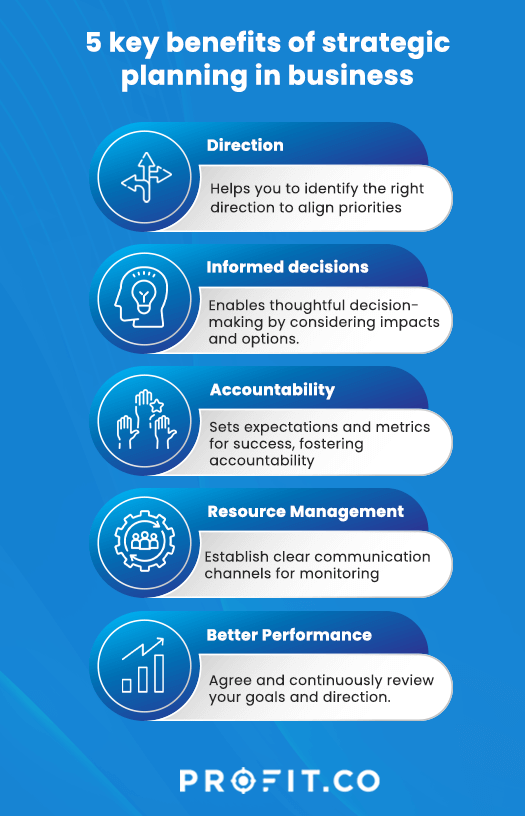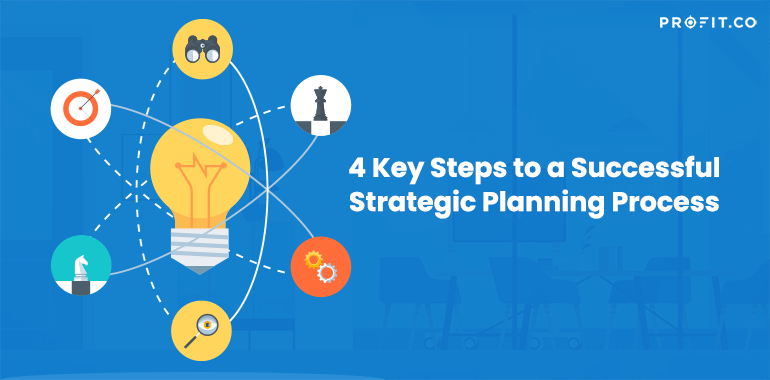Introduction
Strategic planning is a continuous activity that requires discipline, flexibility, and commitment that defines an organization’s long-term goal. The strategic planning process enables businesses to set clear priorities and guide operations toward organizational goals. It involves analyzing the internal and external environment, setting objectives, and developing strategies. By aligning resources, prioritizing actions, and adapting to changes, strategic planning helps organizations stay focused and increase their chances of success.
Learn about the exciting benefits of strategic planning and the four essential steps you must take in the strategic planning process.
Importance of Strategic Planning
A strategic plan offers five benefits for a business
- Direction: Strategic planning identifies what’s important to the organization and focuses everyone’s efforts to achieve it.
- Informed decisions: A strategic plan puts business choices in perspective. Instead of making hasty decisions for short-term benefits, managers can use the strategic plan to consider all possible impacts and options before making decisions.
- Accountability: Strategy steps involve setting expectations and performance indicators of success. Stakeholders can hold themselves to these metrics to improve their outcomes.
- Resource management: A strategic plan helps businesses match their resources to their goals and objectives. This approach improves efficiency and profitability.
- Better performance: A strategy outlines what success looks like through setting targets, milestones, and KPIs. This, in turn, motivates teams to perform better and achieve these goals.
Good fortune is what happens when opportunity meets with planning
Four Steps of a Successful Strategic Planning Process
Did you know that only 30% of C-level managers understand how their organizational strategies work? Studies also indicate that nearly 2/3rds of strategies falter due to flawed execution. So, this is where we realize the significance of the strategic planning process in organizations.
Profit.co’s Strategy module is crucial in aligning execution with strategic intent. Aids in establishing a high-level plan spanning 1-5 years, laying the groundwork for your long-term objectives.
To help you more with it, we have developed these 4 steps that will help you accelerate strategic planning right away! A successful strategy is inclusive, realistic, and directly linked to the company’s bottom line. Follow these steps to create an effective strategic plan for your business

Step 1: Clarify Purpose and Direction
Begin by defining your company’s vision, mission, and values in a few sentences. State why your business exists and what it hopes to achieve over time. Write down the beliefs and principles that inform your organization’s choices and behaviors. This initial step requires reflection and consultation to get to the heart of your business.
Initiatives
- Use tools like surveys, workshops, or focus groups with your stakeholders.
- Get to the core of your company’s values and aspirations
- Use concise and inspirational language to capture the purpose and direction your business should attain.
Step 2: Conduct a Situation Analysis
Internal situation analysis focuses on your available resources, capabilities, and company culture. This is where you engage with staff and review everyday operational procedures.
The external situational analysis focuses on your industry, target market, and the greater economy and socio-political environment. A situational analysis is critical to the strategic planning process because it’s a comprehensive look at your current business situation. It also reveals potential risks to avoid and steps to adapt to industry trends.
Initiatives
- Use customer surveys, competitor analysis, and overall market trends to see where your company lies.
- Assess your internal and external business environment to understand your strengths, weaknesses, opportunities, and threats using the (SWOT) analysis.
Step 3: Set Strategic Objectives and Goals
Strategic objectives and goals align with your purpose and direction (step 1) and your SWOT outcomes (step 2).
Now ensure you set SMART goals: specific, measurable, achievable, relevant, and time-bound. These goals should be long-term targets with a clear progression to help managers and employees manage their workloads. This step of the strategic planning process requires communication and collaboration.
Initiatives
- Identify your main priorities, improvement opportunities, and short, medium, and long-term targets.
- Conduct Surveys, workshops, and one-on-one meetings with essential team members to go a long way.
Step 4: Develop and Implement the Action Plan
The last of the strategy steps involves breaking down your objectives and goals into a detailed plan. This is where you get into your market and competitor analysis, target market segments, value proposition, buyer personas, etc. Also, create your strategy implementation plan with your budget, timeline, and KPIs.This is arguably the most challenging strategic planning step because it explains the practicalities of running your business.
Initiatives
- Assign team responsibilities, and streamline your communication plan.
- Choose an agile performance management solution to monitor organizational progress.
Don’t miss out on the game-changing insights and practical strategies with Profit.co
Common Challenges of The Strategic Planning Process
These 4 steps of strategic planning present numerous challenges, particularly during implementation. Let’s consider these pitfalls and how to overcome them in your strategic planning process.
1. No Alignment
Businesses must ensure that all stakeholders are on board with the strategic plan. Unfortunately, many strategies fail to coordinate action plans across various business units. The best way to overcome this problem is to involve all your stakeholders in all 4 steps of strategic planning. Be prepared to listen and respond to their input while creating your business strategy.
2. Poor Research
An effective strategic plan relies on accurate, actionable data about customer and industry trends, risks, opportunities, and contingencies. Without thorough research, your strategy steps are uncertain, and stakeholders lose confidence in the action plan. Take the time and expertise you need to gather information about your business strategy to gain more clarity on the strategic planning steps.
3. Resistance to Change
Change management is part of strategy implementation to help an organization adapt to the strategic plan. While resisting change is a natural response, businesses should invest in better communication and training opportunities to support their staff during implementation. Involve employees in all strategy steps to minimize friction and misunderstandings.
4. Lack of Resources
Creating and implementing a business strategy requires time, money, technology, experts, and other resources. Businesses with already limited resources often struggle with strategic planning steps. One way to overcome this challenge is to prioritize strategy implementation when allocating your budget and staff workloads. You can also consider partnering with other businesses to share resources to support your strategy.
5. Poor Success Tracking
Businesses also struggle to quantify or measure strategy outcomes tangibly. Frameworks like objectives and key results (OKRs) can help define success metrics. Ensure you have clearly defined goals and objectives before implementing any success measurement framework to track your progress.
Conclusion
The strategic planning process outlined in this guide applies to all organizations, but you can break it down further depending on your specific business. It’s also an iterative process, meaning you must monitor and revise your strategic plan based on stakeholder feedback and success metrics. When challenges arise during the strategy steps or implementation, consider adjusting your business priorities to focus more on the strategy, improving your communication, and collaborating with peers and experts for support.

